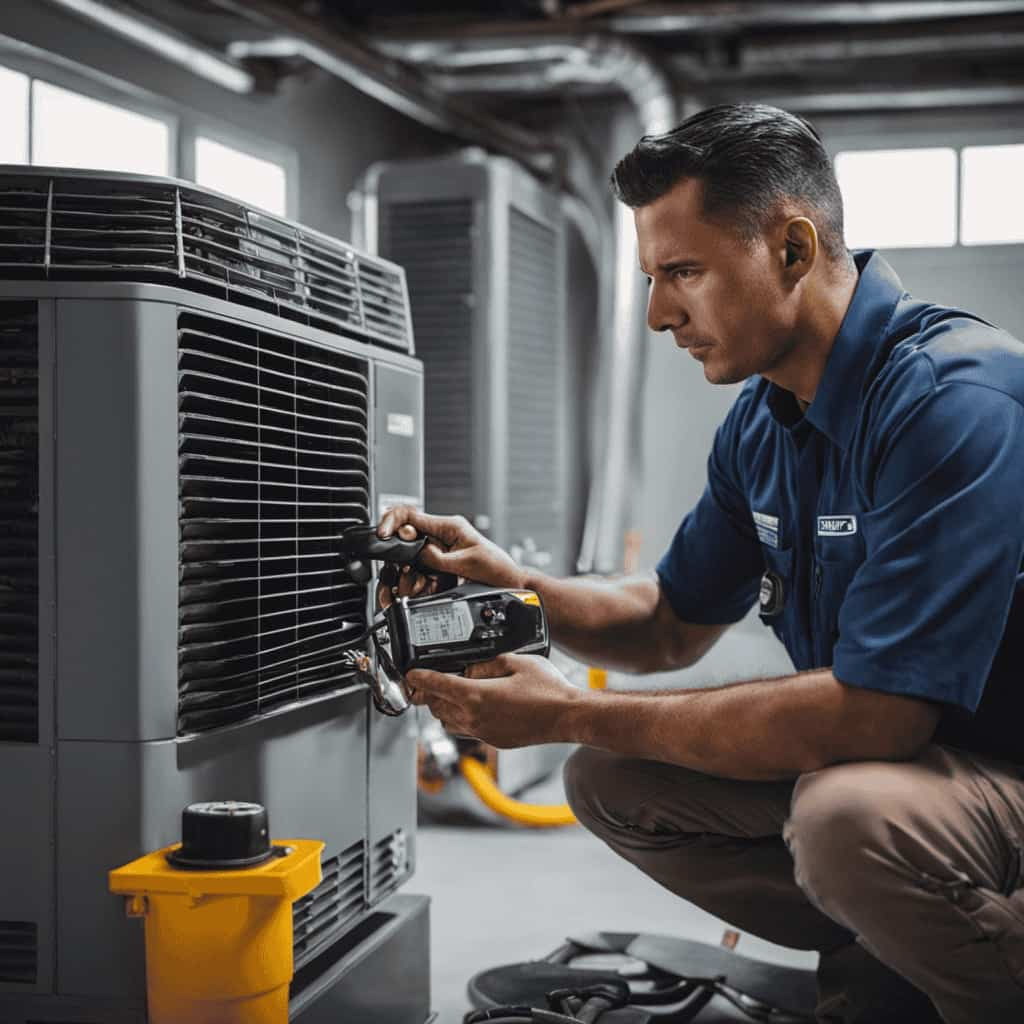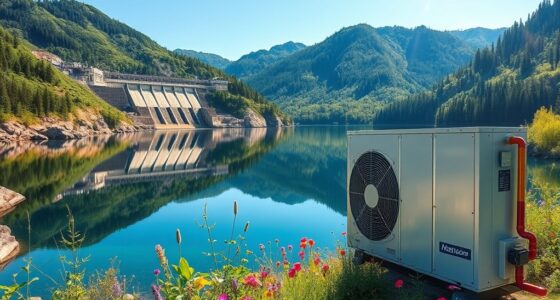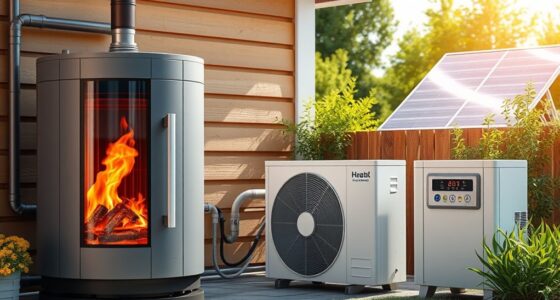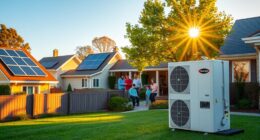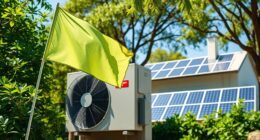Are you tired of feeling like you’re wasting money on inefficient heating and cooling systems? Look no further! In our comprehensive guide, we, the experts, will unlock the secrets to understanding heat pump ratings and energy efficiency.
Get ready to dive deep into the world of SEER, HSPF, and EER as we explore the key factors that affect your heat pump’s performance.
Say goodbye to high energy bills and hello to a more efficient home!
Key Takeaways
- Energy efficiency ratings are important for determining the performance and cost-effectiveness of heat pumps.
- SEER (Seasonal Energy Efficiency Ratio) measures cooling efficiency, while HSPF (Heating Seasonal Performance Factor) measures heating efficiency.
- Considering multiple ratings like SEER, HSPF, and EER (Energy Efficiency Ratio) helps in evaluating the overall energy efficiency of a heat pump.
- Factors such as climate, installation, maintenance, and insulation can affect the real-world energy efficiency of heat pumps.
The Importance of Energy Efficiency Ratings in Heat Pumps
We believe understanding energy efficiency ratings is crucial when evaluating heat pumps. Energy efficiency ratings provide valuable information about the performance and cost-effectiveness of a heat pump. These ratings are standardized and regulated by government agencies to ensure accuracy and transparency.

The role of government regulations is to establish minimum efficiency standards that manufacturers must meet, encouraging the production of more energy-efficient heat pumps. By choosing a heat pump with a higher energy efficiency rating, homeowners can enjoy several benefits.
Firstly, energy-efficient heat pumps consume less electricity, resulting in lower energy bills. Secondly, they have a reduced environmental impact by using less fossil fuel and emitting fewer greenhouse gases. Lastly, energy-efficient heat pumps provide more consistent heating and cooling, ensuring greater comfort and indoor air quality.
Considering the role of government regulations and the benefits of energy-efficient heat pumps, it’s clear that understanding energy efficiency ratings is vital for making informed decisions.
Understanding SEER: The Key to Energy Efficiency
Understanding SEER is crucial for evaluating the energy efficiency of heat pumps. SEER, or Seasonal Energy Efficiency Ratio, is a rating that measures the cooling efficiency of a heat pump or air conditioner.

Here are some key points to consider when understanding SEER:
SEER benefits: A higher SEER rating indicates a more energy-efficient system, which can result in lower energy bills and reduced carbon footprint. It allows consumers to compare the efficiency of different heat pumps and make informed purchasing decisions.
SEER limitations: While SEER is an important factor, it only measures cooling efficiency and doesn’t take into account heating efficiency. Additionally, real-world performance may vary depending on factors like climate, installation, and maintenance.
Other factors to consider: SEER should be considered alongside other ratings like EER (Energy Efficiency Ratio) and HSPF (Heating Seasonal Performance Factor) for a complete evaluation of a heat pump’s efficiency.
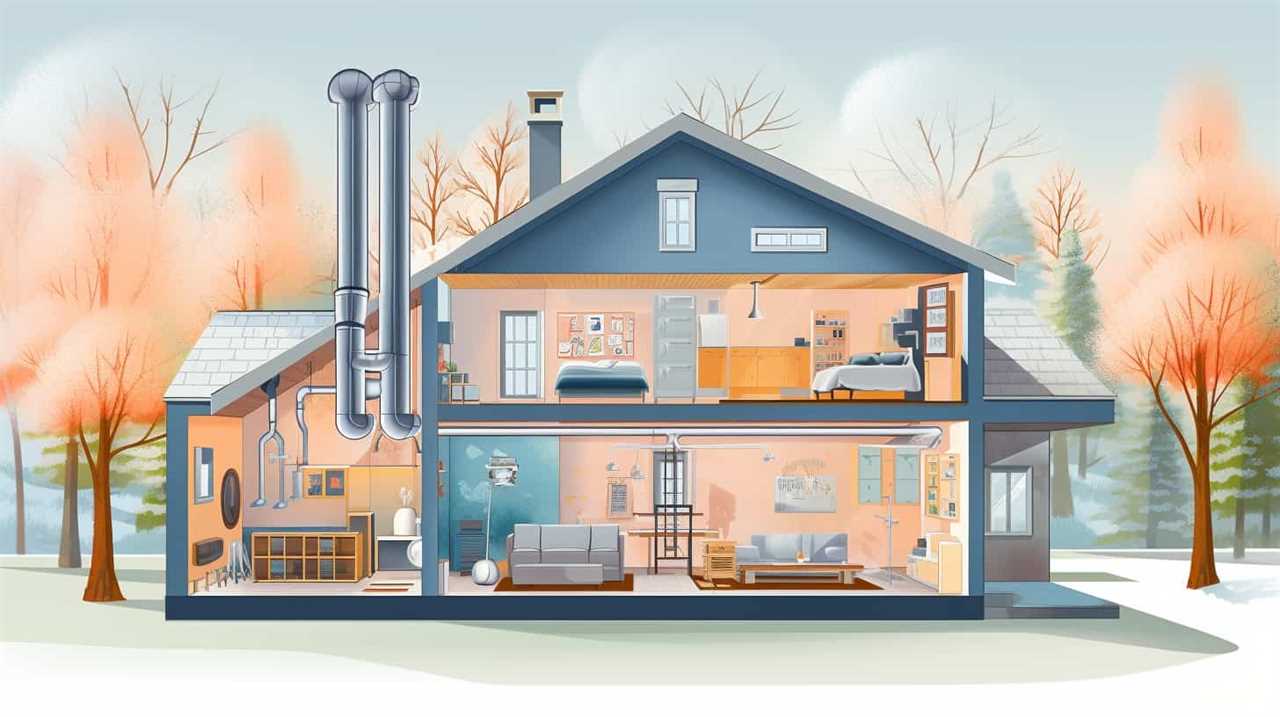
Energy savings potential: A higher SEER rating can potentially result in significant energy savings over the lifespan of the heat pump, making it a wise long-term investment.
Rebates and incentives: Many utility companies and government agencies offer rebates and incentives for purchasing high SEER-rated heat pumps, making them more affordable and attractive options.
Understanding SEER is essential for making informed decisions about heat pumps and maximizing energy efficiency. However, it’s important to also consider other factors and consult professionals for a comprehensive evaluation.
Exploring HSPF: A Measure of Heat Pump Efficiency
How does HSPF measure the efficiency of a heat pump? The Heating Seasonal Performance Factor (HSPF) is a measure of heat pump performance that evaluates the efficiency of a heat pump during the heating season. It takes into account both the heating capacity and the electrical energy consumed by the heat pump. HSPF is calculated by dividing the total heating output of the heat pump by the total electrical energy input over the heating season. The higher the HSPF rating, the more efficient the heat pump is at heating your home. When comparing different heat pump models, it is important to consider the HSPF rating along with other factors such as SEER and EER. Understanding the HSPF rating can help you make informed decisions about heat pump technology and choose the most energy-efficient option for your home. In the next section, we will delve into another important measure of heat pump efficiency: EER (Energy Efficiency Ratio).
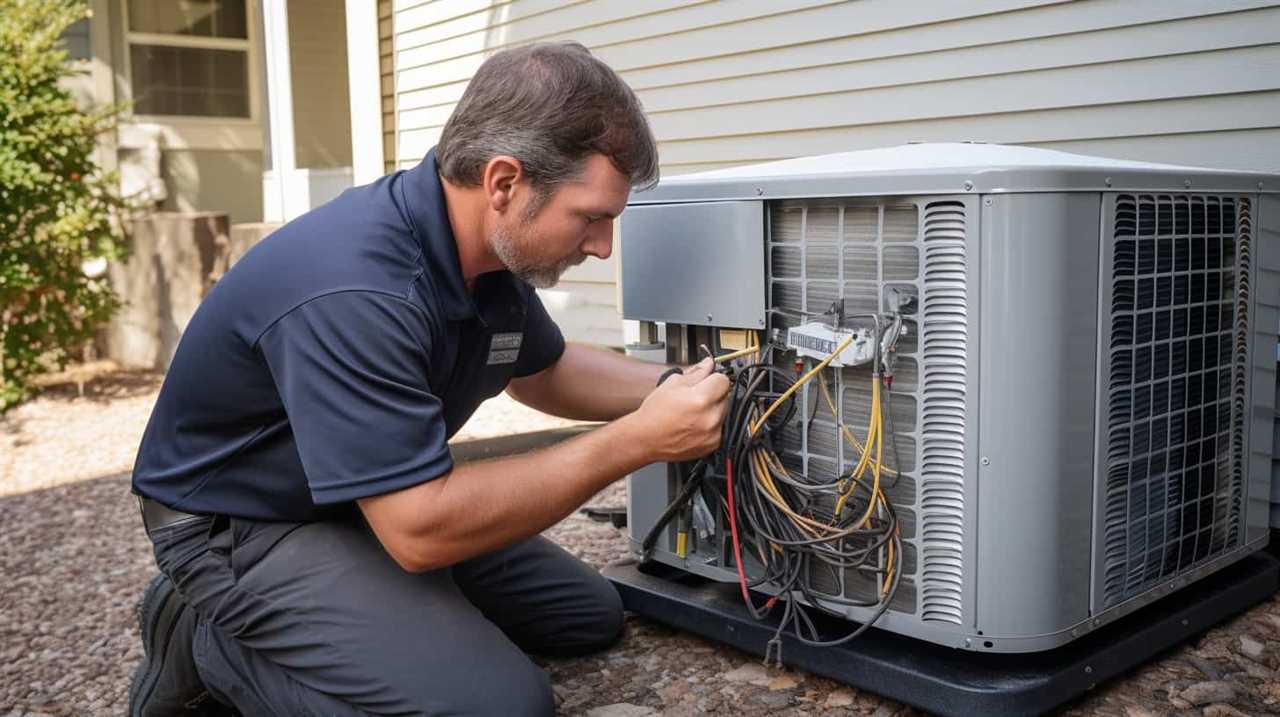
| HSPF Rating | Heat Output | Electrical Energy Input (kWh) |
|---|---|---|
| 8 | 24,000 | 3,000 |
| 10 | 30,000 | 3,500 |
| 12 | 36,000 | 4,000 |
| 14 | 42,000 | 4,500 |
| 16 | 48,000 | 5,000 |
In the table above, you can see how different HSPF ratings correspond to varying heat output and electrical energy input. The higher the HSPF rating, the more heat output you can expect from the heat pump while using less electrical energy. This table serves as a helpful reference when evaluating heat pump efficiency. Now, let’s move on to understanding the EER and its role in evaluating energy efficiency in heat pumps.
Decoding EER: Evaluating Energy Efficiency in Heat Pumps
Let’s explore the EER (Energy Efficiency Ratio) and how it can be used to evaluate the energy efficiency of heat pumps.
When evaluating the energy efficiency of a heat pump, it’s important to consider the Coefficient of Performance (COP). COP is a comprehensive measure of heat pump performance, indicating how efficiently the heat pump converts electricity into heat or cooling.
Additionally, when comparing energy efficiency standards, it’s worth considering the Seasonal Energy Efficiency Ratio (SEER) and the Heating Seasonal Performance Factor (HSPF). SEER measures the cooling efficiency of a heat pump, while HSPF measures its heating efficiency.

Factors Affecting Energy Efficiency Ratings in Heat Pumps
Analyzing the installation location and ensuring proper maintenance are key factors affecting energy efficiency ratings in heat pumps.
The efficiency of a heat pump is influenced by various factors, including the technology used and the environmental impact.
When it comes to installation location, factors such as insulation, air leakage, and ductwork design play a crucial role in the heat pump’s performance. A well-insulated and properly sealed space ensures that the heat pump doesn’t have to work harder to maintain the desired temperature.
Regular maintenance is also essential for optimal energy efficiency. Cleaning or replacing air filters, checking refrigerant levels, and inspecting ductwork can help improve the heat pump’s efficiency and extend its lifespan.

Considering these factors won’t only enhance energy efficiency but also reduce the environmental impact of heat pump operation.
Frequently Asked Questions
How Often Should I Have My Heat Pump Serviced to Maintain Its Energy Efficiency?
We recommend having your heat pump serviced annually to maintain its energy efficiency. Regular maintenance not only ensures optimal performance but also extends the lifespan of your heat pump, saves energy, and reduces the risk of breakdowns.
Are There Any Government Incentives or Rebates Available for Purchasing Energy-Efficient Heat Pumps?
Yes, there are government incentives and heat pump rebates available for purchasing energy-efficient heat pumps. These incentives and rebates can help offset the cost and encourage the use of more efficient heating and cooling systems.
Can I Install a Heat Pump Myself, or Should I Hire a Professional for Installation?
We absolutely recommend hiring a professional for heat pump installation. While DIY installation might seem tempting, it’s crucial to prioritize safety and expertise. Professionals ensure precise installation, maximizing efficiency and avoiding costly mistakes.
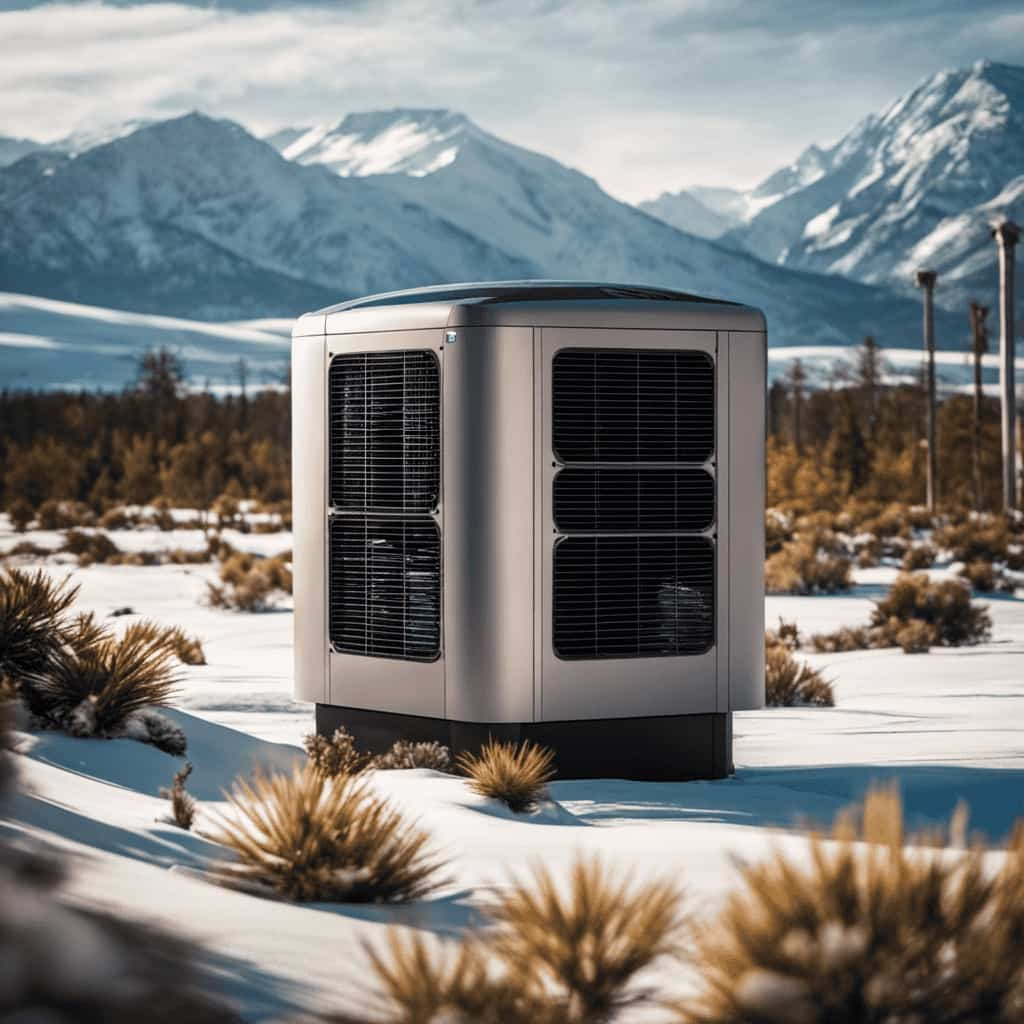
What Are Some Common Signs That My Heat Pump May Be Losing Its Energy Efficiency?
We’ve noticed higher electricity bills and reduced heating or cooling capacity, which are common signs that our heat pump may be losing its energy efficiency. It’s important to address these issues promptly to maximize efficiency and save on energy costs.
Are There Any Maintenance Tasks I Can Perform Myself to Help Improve the Energy Efficiency of My Heat Pump?
Sure, there are some DIY maintenance tips we can perform ourselves to improve our heat pump’s energy efficiency. Regular servicing not only increases efficiency but also extends the lifespan of the unit.
How Can I Improve the Energy Efficiency of My Heat Pump?
Looking to enhance your heat pump energy efficiency? Start by scheduling regular maintenance to ensure proper functioning. Clean or replace filters, check for leaks, and keep the outdoor unit free from debris. Adjust the thermostat and use programmable settings to optimize temperature control. Proper insulation, sealing air leaks, and shading windows can also contribute to improved heat pump performance. Consider these heat pump energy efficiency secrets for maximum cost savings and reduced environmental impact.
Conclusion
As we delve into the world of heat pump ratings, we uncover the key to unlocking energy efficiency. SEER, HSPF, and EER are the symbols that guide us in making informed choices for a sustainable future.
These ratings serve as beacons of knowledge, illuminating the path towards a greener, more efficient way of living. Let’s embrace these symbols, harness their power, and pave the way for a brighter tomorrow.
